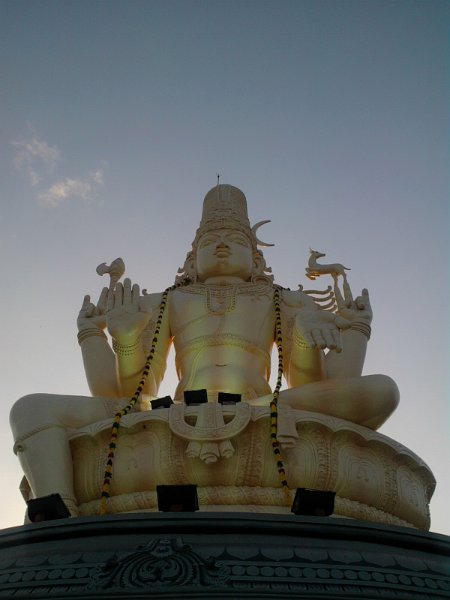Mantra 1
नमो ज्येष्ठाय च कनिष्ठाय च ।
Meaning:
ज्येष्ठाय च- Of the form of those who are superior in age, learning etc., कनिष्ठाय च- to Parameswara in the form of those who do not possess such merits, नमः- prostration.
Mantra 2
नमः पूर्वजाय चापराजाय च ।
Meaning:
पूर्वजाय च- To one who is the first cause of everything, अपरजाय च- to Easwara, who is also the result occuring later, नमः- prostration.
Explanation:
The intent is that Parameswara first appeared as Hiranyagarbha at the beginning of creation and as Kalaagni at the closing time.
Mantra 3
नमो मध्यमाय चापगल्भाय च ।
Meaning:
मध्यमाय च- To one in the form of youth (middle in the aging process), अपगल्भाय च- to Easwara in the form of a boy, नमः- prostration.
Explanation:
‘मध्यमाय’ has also been interpreted as one who takes the forms of beings in the intermediate stage between creation and destruction.
Mantra 4
नमो जघन्याय च बुध्नियाय च ।
Meaning:
जघन्याय च- To one in the form of calf etc. appearing from the rear of cow etc., बुध्नियाय च- to Easwara in the form of root etc. appearing in the bottom of tree etc., नमः- prostration.
Mantra 5
नमस्सोभ्याय च प्रतिसर्याय च ।
Meaning:
सोभ्याय च- To one who appeared in the world of men, प्रतिसर्याय च- to Easwara present in the universe of moving beings, नमः- prostration.
Explanation:
As per the Vedic saying ‘उभाभ्यामेव मनुष्यलोकम्’, this world of men is called ‘सोभः’, as both sin and religious merit are found here. As ‘शाल्वः सोभमधिष्टाय’ is mentioned in Mahabharata, it has been said that ‘सोभः’ refers to a city of Gandharvas. ’प्रतिसरः’ has two meanings: the moving universe capable of shifting from place to place; the sacred thread of protection tied on the hand on auspicious occasions like marriage etc. The import is that Sri Parameswara is the inner presence in all materials.
Mantra 6
नमो याम्याय च क्षेम्याय च ।
Meaning:
याम्याय च- To one present in Yamaloka, क्षेम्याय च- to Easwara present in Swargaloka, नमः- prostration.
Explanation:
Alternatively ‘यमः’ has been interpreted as the time of death and ‘क्षेमः’ as protection, moksha and secret place; this leads to the interpretation of Parameswara as one who appears at the last moment of life, protector, bestower of moksha and one whose abode is secret.
Mantra 7
नम उर्वर्याय च खल्याय च ।
Meaning:
उर्वर्याय च- To one who stays in a place full of all foodgrains, खल्याय च- to Parameswara who is in the threshing floor, नमः- prostration.
Mantra 8
नमः श्लोक्याय चावसान्याय च ।
Meaning:
श्लोक्याय च- To one who is extolled through Vedic mantras (in Karma kanda), अवसान्याय च- to Easwara, established by Upanishads occuring at the end of Vedas, नमः- prostration.
Explanation:
The above terms can also mean one who is extolled by all verses and who exists when everything comes to an end.
Mantra 9
नमो वन्याय च कक्ष्याय च ।
Meaning:
वन्याय च- To one in the form of tree etc. in the forest, कक्ष्याय च- to Easwara in the form of plant, creeper etc. in bushes, नमः- prostration.
Mantra 10
नमः श्रवाय च प्रतिश्रवाय च ।
Meaning:
श्रवाय च- To one in the form of sound, प्रतिश्रवाय च- to Easwara in the form of echo, नमः- prostration.
Explanation:
Alternatively, the meaning can be one who is famous in all places and who is in the form of answer.
Mantra 11
नम आशुषेणाय चाशुरथाय च ।
Meaning:
आशुषेणाय च- To one who has fast moving army, आशुरथाय च- to Easwara who has fast moving chariot, नमः- prostration.
Mantra 12
नमः शूराय चावभिन्दते च ।
Meaning:
शूराय च- To one who is valorous, अवभिन्दते च- to Easwara, who rends and breaks those who spoil dharma, नमः- prostration.
Mantra 13
नमो वर्मिणे च वरूथिने च ।
Meaning:
वर्मिणे च- To one wearing armour, वरूथिने च- to Parameswara, whose place is such that he can protect the charioteer, नमः- prostration.
Explanation:
There is a place in the chariot called ‘वरूथं’, which is meant for protecting the charioteer in times of emergency. ‘वरूथं’ can also mean excellent home. This leads to the meaning that Parameswara has excellent home.
Mantra 14
नमो बिल्मिने च कवचिने च ।
Meaning:
बिल्मिने च- To one who has turban etc. for protecting the head in times of war, कवचिने च- to Easwara who has armour, नमः- prostration.
Explanation:
वर्म- the dress worn upto the waist. कवचम्- the dress worn upto the ankle. Or, the two words can also mean the dress worn on the body and the mantra etc. chanted for protecting the body respectively.
Mantra 15
नमः श्रुताय च श्रुतसेनाय च ।
Meaning:
श्रुताय च- To one who is famous in Vedas, श्रुतसेनाय च- to Easwara, who has famous armies, नमः- prostration.
Explanation:
For the fifth and sixth Anuvakams, Rishi and Devata are both Parameswara himself. Chandas for the fifth Anuvakam is Mahavirat and for the sixth, Mahapankti.
Dhyanam:
‘गौरीकराम्बुजन्यस्तस्वर्णशैलशरासनम् ।
इषुहस्तं रथारूढं नरनारीतनुं स्मरेत् ॥‘
‘One should meditate on the Ardhanareeswara form, with half the body being male and the other half, female; having bow of Meru Mountain, given in the hand of Parvati; with arrow in his own hand; and, seated in the chariot.’
It has been said that the fruit of chanting this mantra consists of victory over enemies, long life, expansion of kingdom, attainment of good son etc. and that by consuming ‘charu’ (rice, barley and pulse boiled and used in oblation to Gods) for three days and chanting this mantra for 11 days without break, one can attain mastery over the power of the mantra.
Translated by: P R Kannan, Navi Mumbai from Commentary in Tamil by
Sri R. MUTHUKRISHNA SASTRI,
Former Editor, Hitabhashini,
Thanjavur
&
Dr.S.SRINIVASA SARMA
Srimatham, Kanchipuram
|

